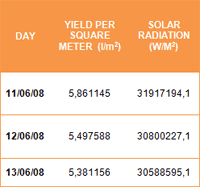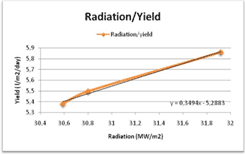 COUNTRY OF ORIGIN
COUNTRY OF ORIGINSOLWA (SOLar WAter)
Results
The SOLWA solar still is constructed from easily accessible parts and demands minimal technical and scientific knowledge for its construction. It can be easily transported and located anywhere, not requiring connections to conventional energy networks. This system allows therefore to solve the needs of water supply in small communities either isolated or with problematic connection to the energy network.
This type of solar still has been devised and researched by the University of Padua, Italy. The prototype model was tested during summer 2008 at the research institute of the University, by a pool of university professors of the Faculties of Sciences and Chemistry and in collaboration with the Faculty of Agrarian Science. At the experimental site of the University of Padua the solar still produced, during the test days and starting from a solution of sea water, the amount of water shown in Table 1.
 |  |
| Table 1. Recorded drinkable water produced during the test period | Figure 3. Ratio between solar radiation and yield per square meter |
In the diagram shown in Figure 3 (ingress radiation and drinkable water produced) the yield of SOLWA solar still is hypothesized in different climatic conditions. It is thought that in desert and tropical climates the water production per square meter will remain over 10 l/m2/day, with a 56% efficiency.
The SOLWA solar still only uses renewable energy, does not require specialized maintenance and has a production cost of water to the m3 close to zero. Other technologies that give the same product (inverse osmosis, diesel-powered MED or MSF stills), have a high environmental impact, since they require a “conventional” energy power (electric power and hydrocarbons). The costs of technologies used in great industrial systems range from 0.45 €/m3 for inverse osmosis to 1.2 €/m3 for other technologies. The current systems require highly specialized labor, the employment of chemical substances for pre and post treatment of waters and high quantity of energy.
Various scientific articles indicate that solar stills have a lifetime at least 20 years. Given the constructive and maintenance characteristics of SOLWA, it is estimated that its lifetime will be significantly longer.
DOWNLOAD THE BROCHURE PDF
Spanish (1.6 MB)English (1.6 MB)
French (3.3 MB)







